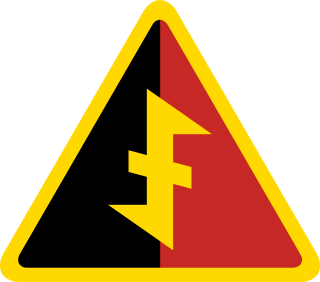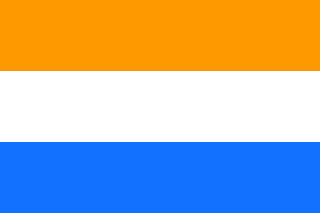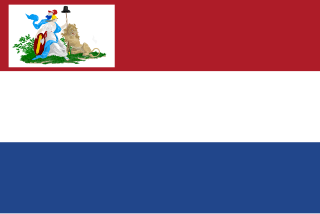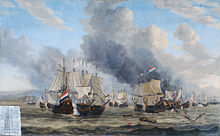
A national flag is a flag that represents and symbolizes a given nation. It is flown by the government of that nation, but can also be flown by its citizens. A national flag is typically designed with specific meanings for its colours and symbols, which may also be used separately from the flag as a symbol of the nation. The design of a national flag is sometimes altered after the occurrence of important historical events.

The national flag of the Netherlands is a horizontal tricolour of red, white, and blue. The current design originates as a variant of the late 16th century orange-white-blue Prinsenvlag, evolving in the early 17th century as the red-white-blue Statenvlag, the naval flag of the States-General of the Dutch Republic, making the Dutch flag the oldest tricolour flag in continuous use. As a flag that symbolises the transformation from monarchy to republic, it has inspired both the derivative Russian flag, and after the French Revolution in 1789, the vertically striped French tricolour; both flags in turn influenced many other tricolours. During the economic crisis of the 1930s, the old Prince's Flag with the colour orange gained some popularity among some people. To end the confusion, the colours red, white and blue and its official status as the national flag of the Kingdom of the Netherlands were reaffirmed by royal decree on 19 February 1937.

The national flag of France is a tricolour featuring three vertical bands coloured blue, white, and red. The design was adopted after the French Revolution, whose revolutionaries were influenced by the horizontally striped red-white-blue flag of the Netherlands. While not the first tricolour, it became one of the most influential flags in history. The tricolour scheme was later adopted by many other nations in Europe and elsewhere, and, according to the Encyclopædia Britannica has historically stood "in symbolic opposition to the autocratic and clericalist royal standards of the past".

The national flag of Estonia is a tricolour featuring three equal horizontal bands of blue at the top, black in the centre, and white at the bottom. The flag is called sinimustvalge in Estonian.

The National Socialist Movement in the Netherlands was a Dutch fascist and later Nazi political organisation that eventually became a political party. As a parliamentary party participating in legislative elections, the NSB had some success during the 1930s. Under German occupation, it remained the only legal party in the Netherlands during most of the Second World War.

The national flag of the Russian Federation is a tricolour of three equal horizontal bands: white on the top, blue in the middle, and red on the bottom.

The national flag of Armenia, also known as the Tricolour, consists of three horizontal bands of equal width, red on the top, blue in the middle, and orange on the bottom. The Armenian Supreme Soviet adopted the current flag on 24 August 1990. On 15 June 2006, the Law on the National Flag of Armenia, governing its usage, was passed by the National Assembly of Armenia.

The flag of North Brabant consists of a chequy pattern with 24 distinct fields in the colours red and white or gules and argent. The flag has been used since the Middle Ages, but fell into disuse in the 18th century. The flag is now back in use, and has been the official flag of North Brabant since 1959.
A triband is a type of flag which consists of three stripes arranged to form a flag. These stripes may be two or three colours, and may have an emblem in the middle stripe. All tricolour flags are tribands, but not all tribands are tricolour flags, which requires three unique colours.

The current city flag of Amsterdam depicts three Saint Andrew's Crosses and is based on the escutcheon in the coat of arms of Amsterdam. The flag is very similar to the flag of Amstelveen.

The flag of South Holland was adopted on 24 October 1985, replacing the flag used since 22 June 1948. The flag shows a red lion standing out prominently against an even yellow background. The flag of the most populous province is a banner of arms of the South Holland coat of arms. This shield is in turn grafted onto the coat of arms of Holland. The colour choice is also obvious; after all, yellow and red have traditionally been the colours of the province of Holland. The aspect ratio of the South Holland flag is 2:3, which are the same dimensions that also apply to the national tricolour. The left-facing lion, standing on its hind legs, occupies three-quarters of the flag's height and is equally distant from the top and bottom. The colours red and yellow are Holland's traditional colours and are also found of the flag of North Holland.

The flag of the Caribbean Netherlands island of Sint Eustatius (Statia) consists of a blue field, red fimbriations, and in the center, a white diamond with a silhouette of the island. The flag was designed by Zuwena Suares and adopted on 29 July 2004 to be put into use on 16 November of that year. Since 2010, it has been the official flag of the special municipality of Sint Eustatius.

The flag of North Holland is the official flag of North Holland. The flag consists of three horizontal bands executed in the colours yellow, red and blue. The colours are taken from the coat of arms of North Holland. This in turn is a combination of the old coats of arms of North Holland and West Friesland. Yellow and red belong to Holland, while blue is part of the West Frisian identity. The current design was adopted by the Provincial Council on 22 October 1958 as the official tricolour of North Holland. The colour sequence of the North Holland flag was also determined this way in the current design because otherwise the flag would look too much like the red-white-blue striping pattern of the Dutch flag.

The Flag of New Holland, also known as the flag of Dutch Brazil, was the flag used by the Dutch West India Company for the territories that were under its control in Brazil from 1630 until 1654. In this period, Brazil was not granted its own flag, and only the flags of its colonizers or rulers were used.

The Prince's Flag is a Dutch flag, first used in the Dutch Revolt during the late 16th century.

The Batavian flag is a Dutch historical flag. It was designed by Dirk Langendijk in January 1796, and introduced in March 1796 as the official flag of the navy of the Batavian Republic, replacing the Statenvlag.

Jhr. Johannes Cornelis de Jonge was a Dutch Rijksarchivaris, historian, and politician. He is best known for his encyclopedic Geschiedenis van het Nederlandsche Zeewezen, a naval history of the Netherlands that was based on the Dutch naval archives, a large part of which were destroyed in a fire in the archives of the Dutch Department of the Navy in 1844. By default therefore this history had to come in the place of the lost primary documents.

The Flags of the United States of Indonesia refers to the state flags that were used as the official state symbols of the United States of Indonesia, the predecessor state of the Republic of Indonesia. The flag that were hoisted during the proclamation of independence on 17 August 1945 remained as the official flag of the United States of Indonesia after its transfer of sovereignty on December 27, 1949, and it was written on the Federal Constitution of 1949.
Oranje boven is a Dutch pro-monarchy folk song which represents Dutch fondness for its royal family, the House of Orange-Nassau. It is a contrafact, sharing the same melody as the children's song "We zijn er bijna ".






















